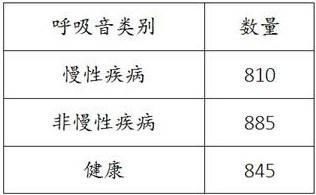Lung disease auscultation system, signal processing method and equipment based on convolutional neural network
A convolutional neural network, lung disease technology, applied in the field of lung disease auscultation system, can solve the problems of complex algorithm, huge network structure, difficult mobile terminal, etc., to achieve the effect of convenient feature extraction and small system calculation amount
- Summary
- Abstract
- Description
- Claims
- Application Information
AI Technical Summary
Problems solved by technology
Method used
Image
Examples
Embodiment 1
[0062] In the technical solution disclosed in one or more embodiments, as shown in FIGS. 1-7 , a convolutional neural network-based pulmonary auscultation system is provided, including:
[0063] The preprocessing module is configured to preprocess the acquired breath sound signal, and normalize the breath sound signal in turn;
[0064] A data conversion module configured to extract audio features from normalized data to generate Mel Spectrogram (MelSpectrogram) data;
[0065] The data enhancement module is configured to utilize the data enhancement model to perform data amplification on the generated mel spectrum data;
[0066] The convolutional neural network module is configured to use the trained deep learning model to perform feature extraction on the amplified mel spectrum data;
[0067] The feature classification module is configured to classify the extracted features using the trained low-discrepancy forest classifier to obtain a classification result.
[0068] In thi...
Embodiment 2
[0135] Based on Embodiment 1, this embodiment provides a terminal device, including a memory, a processor, and computer instructions stored in the memory and run on the processor. When the computer instructions are executed by the processor, the following steps are performed:
[0136] Preprocessing the acquired breath sound signal, and normalizing the breath sound signal in turn;
[0137] Extract audio features from the normalized data to generate Mel spectrum data;
[0138] Use the data enhancement model to amplify the generated mel spectrum data;
[0139] Use the trained deep learning model to extract features from the amplified Mel spectrum data;
[0140] The extracted features are classified by the trained low-discrepancy forest classifier, and the classification results are obtained.
PUM
 Login to View More
Login to View More Abstract
Description
Claims
Application Information
 Login to View More
Login to View More - R&D
- Intellectual Property
- Life Sciences
- Materials
- Tech Scout
- Unparalleled Data Quality
- Higher Quality Content
- 60% Fewer Hallucinations
Browse by: Latest US Patents, China's latest patents, Technical Efficacy Thesaurus, Application Domain, Technology Topic, Popular Technical Reports.
© 2025 PatSnap. All rights reserved.Legal|Privacy policy|Modern Slavery Act Transparency Statement|Sitemap|About US| Contact US: help@patsnap.com



